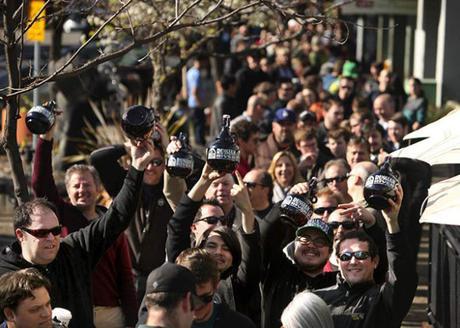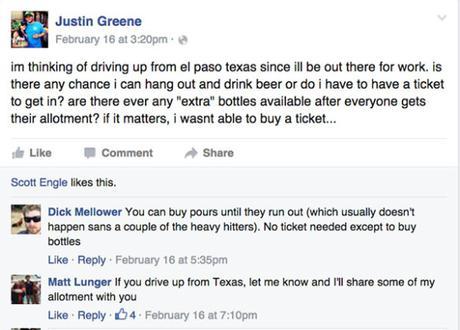
The collection of people waiting was past 100. Many had camped out overnight.
A reporter and cameraman surveyed the crowd. Inside the building, they approached a table of sleepy eyed friends, looking quiet in contemplation. Or maybe they were just zoned out from sleep deprivation.
"How long did you guys stand in line?" the reporter asked the table of eight.
"About 11 hours," they all answered in unison, not blinking.
But a moment later, boy did they look happy to have been some of the first into Russian River Brewing's Pliny the Younger release.
Of course, the annual, one-time sale of the imperial IPA isn't the only occasion for beer lovers to get in a tizzy, whether it's waiting overnight for Foothills Brewing's Sexual Chocolate imperial stout or rioting for Hunaphu's imperial stout at Cigar City Brewing. As the beer world continues to get bigger, it's clear that people are willing to pay in time, money and sanity for the chance of being a part of something small.
Do 25-35 year old white people have nothing better to do than wait in line for a pretty good beer? I saw a line and went...nope
- Ken Goyette (@kgoyette) February 28, 2016
"Scarcity has this effect of making people perceive products as more valuable simply for the fact that they're scarce," business psychologist Nir Eyal told NPR in 2014, when, naturally, the network was covering the hype of Pliny the Elder, the sister beer of Pliny the Younger.
Crazed reactions over scarce items is nothing new, especially in an increasingly locally-focused industry that prides itself on regionalism, if not literal hometown favoritism. But whether you're a local hoping for a legendary bottle of beer or an out-of-towner traveling hundreds of miles for your chance at fermented immortality, the power of scarcity is real, it is psychological and it is physiological.
When it comes to our internal cost-benefit analysis of these situations, does the perceived benefit trump logic? Can scarcity marketing rule our minds as well as our pint glasses?
Limited, annual releases may draw attention from beer hoarders everywhere, but it's simply part of a successful business strategy at Colorado's Casey Brewing. Located in remote Glenwood Springs, RateBeer's 2015 "Best New Brewery in the World" sees hundreds of fans making the trek for monthly releases.

It's a situation that owner and brewer Troy Casey told the Denver Post benefits him. "Some mystique is lost," he said, if he makes too much beer:
The plan calls for limited growth, progressing from about 100 cases a month of production when the business began to the current levels of 200 to 250 cases, His goal is to reach 400. A case holds a dozen bottles.
"That is pretty strange. Most businesses, if there is a demand, you want to meet that. But I have seen brewers do that model, and something has to give - either the quality of the beer or the happiness of that person's life. I don't want that."
If that's a business plan and prerogative of the owner, so be it. Because the flip side - beer geeks themselves - is even worse. Just consider this list of sins, recently highlighted in the Daily Beast:
- Enlisting the elderly to mule bottles of beer
- Using disguises to buy more than one person's allotment of beer
- Using professional line waiting services
- Paying $20 for a 1-in-40 chance of winning a beer
- Rioting
"I'm sick of hearing 'Oh my God this beer is $149, can you believe it?'" Off Color's John Laffler told Porch Drinking. "That is such bullshit and then the media falls for it and then people keep doing it because it gets them attention. You see your name in print and you sell more base beer because your name is in print."
@RealGarrettV please call to discuss
- Same Ole Line Dudes (@sold_inc) March 9, 2016
To Average Joe and Jane Drinker, all this might sound preposterous, but the truth of the matter is that there are very good reasons why otherwise sensible human beings put themselves through the ringer to pay excessive amounts of money on a perishable good.
Why We CareIt starts with commodity theory, a psychological theory which suggests people value unavailable commodities because of scarcity, even when there is no demand or increased monetary reward associated with the scarcity. Study after study has shown this kind of irrational behavior is accepted in all sorts of situations.
In one example, artificially scarce cookies weren't just more desirable for test subjects versus abundant ones, they were also rated higher in taste. Another looked at desirability and perception for art and wine. With art prints, an assumed expensiveness created an enhancement of desire among participants. When presented with perceived expensiveness and desirability of wine, the idea of scarcity increased interest.
Sound familiar? The simple idea of scarcity is enough to influence people, but if you take it one step further, obtaining a beloved item (imaginary or not) is enough to have some "establish themselves as people of distinctive and distinguished tastes."
In an era of Untappd badge one-upmanship, bottle shares and limited releases, the Whalezbro culture of beer thrives because our brains are attuned to it.
Look back at the recent #DrinkItNow Day, an effort that encouraged beer lovers to stop sitting on rare bottles and finally drink the damned things. Twitter was littered with posts about beers sitting around for years, status symbols finally cracked open for the world to see.
@nolasox @injest77 just did a beer cellar reorg in honor of #DrinkItNow It might be time for my 04 World Wide Stout. pic.twitter.com/UMNlFZ4CtG
- Dan Mielcarz (@mielcarz) February 21, 2016
Plainly: one way that consumers satisfy their need for uniqueness is by owning rare or difficult-to-obtain items. That release at Casey Brewing attracting a guy to drive 12 hours to Colorado during a business trip to Texas? It's his way of not only identifying with a social group of beer drinkers, but on a base level, assert his importance along the way.
Which is why Troy Casey's business plan isn't so crazy after all.
Should Breweries Care?Consider this: people are paying between $200 and $400 for tickets to this weekend's celebration of imperial stout at Cigar City's Hunaphu's Day, which saw a mini riot two years ago after bottle sales ran dry. Similarly, Three Floyds Brewing is charging $200 for entry into their annual Dark Lord Day.
What is the cost - in time and money - to be a part of similar celebrations near you? What does it take to buy a limited release at your local store? What about the consistent rise of ticket prices to get into events like the Great American Beer Festival, SAVOR or even a regional event?
"If the market is stupid, the market will bear things unwisely," beer writer Jeff Alworth recently said on his Beervana podcast while discussing the topic of scarcity and pricing beers. "What I'd like to say to the market ... you should be able to distinguish this because that brewery is just trying to make a mint off the $15 triple IPA, you should know [a brewer] is making a massive money off that bottle of beer ... He's just asking you to value it at a high rate based on a subjective judgment of goodness."
The quality of products may certainly be rising - at least we hope so, considering a Brewers Association member is in charge of it - but even if that isn't the case across the board, breweries can utilize tactics to increase perceived value of products by simply manipulating the perceived scarcity.
Or, rather, maybe they simply should be.
"Never underestimate a beer geek," Jemma Wilson, Firestone Walker's marketing specialist told the Daily Beast. After all, there's plenty of evidence to show that beer fans won't feel bad about shelling out extra money for unique experiences.
The keys to increasing perceived value are straight forward:
- Advertise a product's scarcity
- Produce limited editions
- Distribute products through exclusive outlets
- Offer prestige pricing of products and services
- Restrict maximum order size
All this is made more important by the increased attention and value placed on the idea of localization. If drinkers want authentic experiences, value "hometown" breweries and express interest in certain kinds of beers, it's a relatively easy recipe to build a following, whether for a beer or brewery. Of course, quality matters, but given the plethora of psychological aspects at play, it isn't the only thing that matters.
With targeted efforts based on demographics, life-style and other characteristics, there is a formula in place. It's just a matter of making sure the result is a rare one.
Beer geeks when a bunch of beer shops announce more Lambo Door cans came in all at once pic.twitter.com/l2U8wtxSTr
- Brew York (@brew_york) February 18, 2016
Related: Beervana podcast on barrel-aged beers. For discussion of this specific topic, skip to about 58 minutes in.
Header image via Petaluma360."Don't drink to get drunk. Drink to enjoy life." - Jack Kerouac

